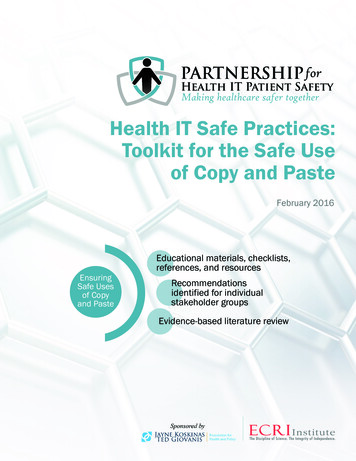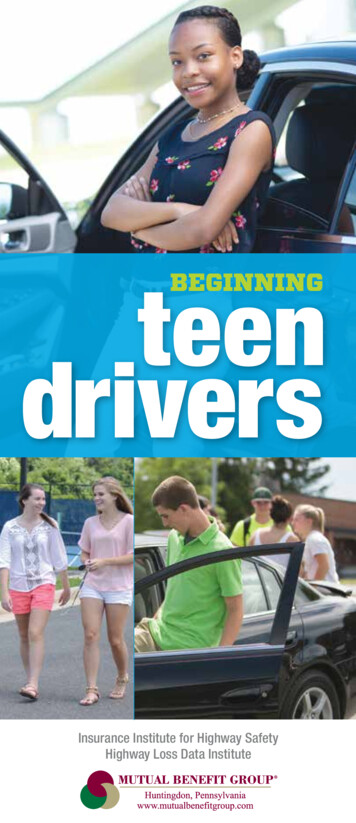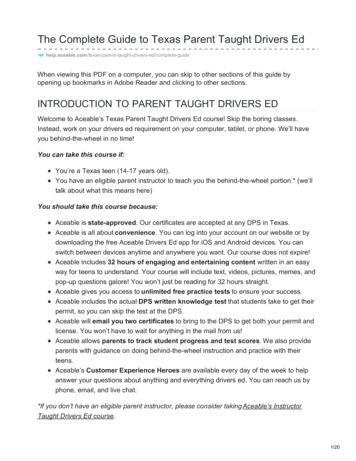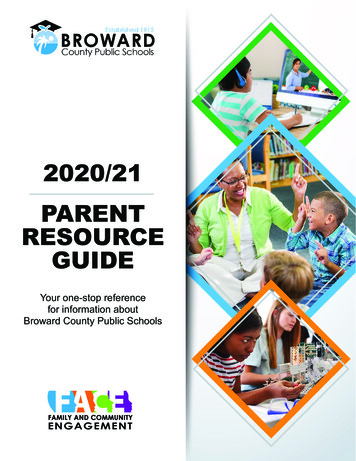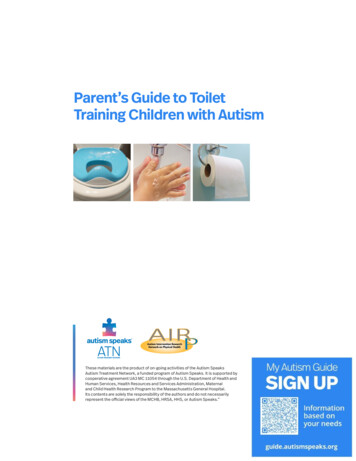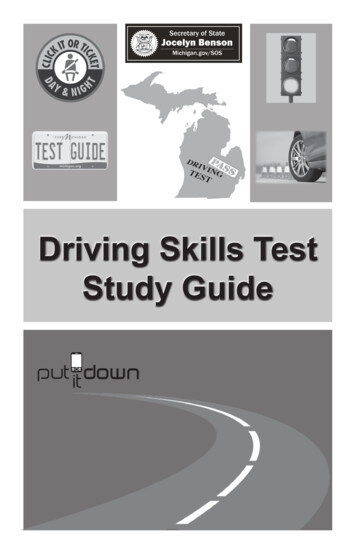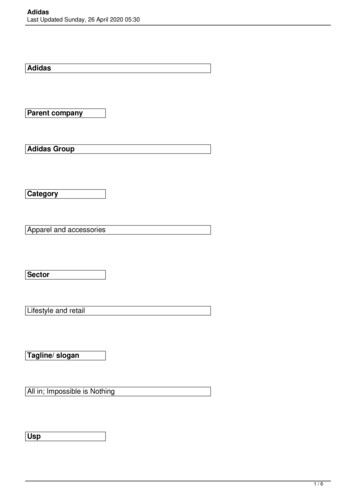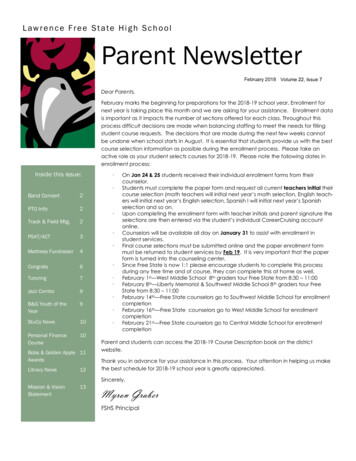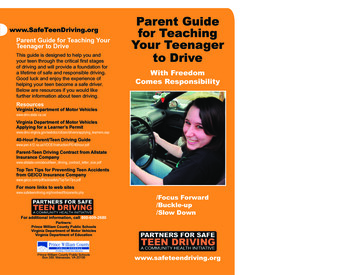
Transcription
www.SafeTeenDriving.orgParent Guide for Teaching YourTeenager to DriveThis guide is designed to help you andyour teen through the critical first stagesof driving and will provide a foundation fora lifetime of safe and responsible driving.Good luck and enjoy the experience ofhelping your teen become a safe driver.Below are resources if you would likefurther information about teen driving.Parent Guidefor TeachingYour Teenagerto DriveWith FreedomComes ResponsibilityResourcesVirginia Department of Motor Vehicleswww.dmv.state.va.us/Virginia Department of Motor VehiclesApplying for a Learner’s applying learners.asp40-Hour Parent/Teen Driving pdfParent-Teen Driving Contract from AllstateInsurance Companywww.allstate.com/about/teen driving contract letter size.pdfTop Ten Tips for Preventing Teen Accidentsfrom GEICO Insurance For more links to web hpFor additional information, call 800-609-2680/Focus Forward/Buckle-up/Slow DownPartners:Prince William County Public SchoolsVirginia Department of Motor VehiclesVirginia Department of EducationPrince William County Public SchoolsBox 389, Manassas, VA 20108www.safeteendriving.org
How do you teach a 16-year-old to besafe and courteous behind the wheel ofan automobile? Unfortunately, there is nomagic formula to prepare your teenagerfor the responsibilities of driving. Drivereducation at its best is a team effortinvolving schools, communities, students,and families.Cars do not crash; people crash them.The driver, especially the young driver,continues to be a weak link in automotivesafety. Each year, more than 100 highschool students are killed and morethan 15,000 students are injured onVirginia’s roadways. Injuries to studentsin car crashes account for more years ofproductive life lost than all other causes.Hospitalization and rehabilitation costs,lost time from school, and other costsassociated with long-term injuries createsubstantial emotional, physical, andfinancial problems for students, schools,and their families.Parents and families – not the school– are in the best position to encourageresponsible behavior and have asustained effect on minimizing risksfaced by inexperienced drivers. Parentalreinforcement of basic driving skills andgood decision making will lead to safedriving habits that will last a lifetime.Our Virginia teens need our help andguidance to practice the skills necessary todrive safely and responsibly.Parents:Be a Role Modelfor the Road!Visit Partners for Safe Teen Driving atwww.safeteendriving.orgfor information, news articles, and factsthat teens and parents will find valuable.Your biggest contribution to your teendriver’s safety and skill behind the wheelwill be your example. Patience, courtesy,and a willingness to improve will be yourbest assets. Now is the time to review yourown driving habits and offer your teen theexample of courtesy and consideration forother road users. This may do more thananything else to ensure your teen’s drivingsafety.
Coaching YourTeenager’s DrivingThe Virginia Department of MotorVehicles and Prince William County PublicSchools are partnering for teen driversafety. Partners for Safe Teen Driving aneducationally focused community healthinitiative that is designed to educateparents about what they can do to betterprepare their teens for driving.Driving an automobile is the mostdangerous behavior any Virginian does,and the first 1,000 hours for the beginningdriver are the most perilous. Parents canhelp their teen become a better driver byunderstanding the following significantfactors for safe teen driving: Knowledge of behind-the-wheelinstruction; Knowledge of Virginia licensingprocedures for beginning drivers; Knowledge of Virginia trafficlaws and teenage drivers; and Knowledge of parent coachingmethods and strategies.As the parent of a teenager learning todrive, you are likely to be concerned aboutthe welfare and safety of your child. Thereare two major steps to take in teachingyour child to drive. First, review yourown driving habits and offer your teenan example of safe driving practices andcourtesy for other road users. This maydo more than anything else to ensure yourteenager’s driving safety. Second, makeyour teenager’s practice driving sessionssafe, positive, and productive by followingthe tips below.Set a good example: Always wear your safety belt. Correct any unsafe driving habitsthat you may have acquired. Demonstrate your knowledge ofVirginia traffic laws. Drive within the speed limits.Your biggest contribution to your teen’ssafety and effectiveness behind the wheelwill be your example. Patience, courtesy,and a willingness to share will be your bestassets.
RoadCommentary DrivingThis technique is used with more advanceddrivers. The driver is asked to do a runningcommentary on what hazards or factors heor she is taking into account while driving.(“Car turning left ahead,” “approachingcrosswalk,” “car overtaking in the left lane,”etc.)Tips on CoachingYour Teen’s Driving Follow the Virginia Departmentof Education’s 40-Hour Teen/Parent Driving Guide. Enjoy your time together. Havefun! This is a great “bonding”opportunity. Focus on thedriving task and leave familyissues at home. Clear your own schedule andmark your calendar for practicetimes and remain consistent. Designate and pre-determine aplace to practice. Let your teenager know you careabout his or her safety whilepracticing. Stay calm, rational, upbeat, andengaged. Insist that your teen makesafety and instrumentadjustments before driving:- Adjust the rearview mirrors.- Reposition the seat beforedriving.- Adjust and fasten safety belts.- Set temperature adjustments.- Turn off the radio or CD player.Attitude determines how knowledge andskills will be used. It determines whethera driver will be cooperative or competitivein traffic, will choose a safe or high levelof risk, and/or will put into practice theconcepts taught on defensive drivingcourses.
12-Second RuleIdeally, the defensive driver is anticipatingtraffic movements and potential hazardsas far away as the point the car will reachin 12 seconds. Within this distance thedriver should scan the scene, includingsidewalks, and make adjustments to speedand position as necessary.Smith SystemThe Smith System is one of the mostwidely used methods for improvingdefensive driving. It provides five rules fortraining the eyes to see what is importantin driving. They are: Aim high (to steer accurately andanticipate problems). Keep your eyes moving (avoid a fixedstare, stay alert). Get the big picture (don’t allow youreyes to be drawn to one area). Leave yourself an “out” (practicethe “what if . . .” game). Make sure they see you (whennecessary make eye contact with otherdrivers and use warning devices at theproper time).These rules sound simple but it takesconsiderable practice to develop the habitof using them at all times in traffic. Goodmanagement of space and time allows theSmith System driver to use the five rulesmost effectively, always having time toscan the scene around the car and adjustspeed and position to minimize hazards. Your coaching commentsshould make your teen moreaware, rather than feel ashamed orjudged. Don’t use instructional time in thecar to discipline your teenagerabout other matters. Check to make sure your child hasa learner’s permit, vehicleregistration card, and insuranceinformation with him or her whenoperating a vehicle. If possible, begin instruction in acar with an automatictransmission so that your childcan focus on mastering basicvehicle control maneuvers.Coach Your Teenager toAssess and Manage DrivingRisks Look far down the road. Look asfar down the road as possible touncover important trafficinformation to make the best decision. See the big picture. Maintain properfollowing distance and don’t tailgate. Keep your eyes scanning. Don’tstare. Constantly check side andrearview mirrors. Stay alert. Leave yourself a way out. Beprepared. Surround your vehicle withspace in front and at least on one sideto escape collisions. Make sure other drivers see you.Use your signals and the horn ifnecessary. Make eye contact withother motorists in a non-threateningmanner. Be reasonably sure of theother driver’s intentions.
AdolescentDevelopment andDrivingDriving is far from a simple task foranyone. It is a mix of decision making andmotor responses all controlled by specificbrain areas. Recent research on the brainhas revealed that neural circuitry is notfully developed in decision-making areasuntil the mid-20s. This may be one reasonwhy teenagers and those up to age 25 areat high risk for accidents when they arebehind the wheel.What do we know about the“neural circuitry” of adolescents?In the last two decades, functionalmagnetic resonance imaging (fMRI) hasprovided insights never before availableinto brain functioning. Scientists nowknow that the decision-making portion of ateenager’s brain is not mature and that theimpulse control portion of brain does notphysically mature until about age 25.Teenagers, when compared to adults, donot have the same impulse control andability to recognize and stop potentiallydangerous behaviors. The prefrontalcortex, the area immediately behind theforehead, is responsible for judgmentand decision making and is the last partof the brain to fully develop. As a result,teenagers often fail to realize that fastdriving, drinking and driving, drag racing,and filling a car with passengers aredangerous activities.2-Second Rule(3 seconds for beginners)This provides safe spacing when followinganother car at any speed. By noting whena car ahead of you passes a fixed pointand counting your time to reach that samepoint, you can determine whether yourspace is safe. Two seconds (count “onethousand and one, one thousand andtwo”) is the minimum safe space. Thisshould be practiced by beginning driversfrom the passenger seat! The beginnerwill then develop a sense of what a safespace looks like at different speeds. Withbeginning drivers, three seconds shouldbe the minimum distance to follow othervehicles.4-Second RuleThis is an approximate time needed tostop at speeds over 35 miles an hour. Tocalculate, choose a fixed point on theroadway ahead and count the secondsuntil you get there. If you reach that pointunder four seconds, you would probablynot be able to stop safely. If you reach thatpoint after four seconds, you would be ableto stop in time to avoid a collision.
Effective PracticesManage Risk byDeveloping CarefulDriving HabitsBeing a good driver means more than justbeing cautious, and mere experience isn’tenough either. A good driver has to workat developing sound driving habits. Thefollowing is a review of effective practicestaught in driver education classes thatpromote the development of safe andresponsible driving behaviors.Teenagers need active parental supervision,especially where driving is concerned.With this research in mind, discuss with yourteenager: What risky driving behaviors are andhow to recognize them; “Doing the right things” and managingrisk while driving; How to handle peer pressure; The reality that driving is seriousbusiness, even though advertisingmessages show everyone having fun;and That over time driving experience paysoff, but right now your teenager is in alearning curve.Managing Space and TimeA driver must have space to maneuverand time to react. The following time ruleshelp beginning drivers compensate for theirinexperience and are proven techniques atreducing risk in traffic.Based on what is known about adolescentdevelopment, here are five tips for parentsof teen drivers: Be a role model for safe driving. Have patience and offer praise fordoing the right thing and obeying thelaw. Talk frequently about safe drivinghabits. Set clear limits and expectations foryour teens driving. Practice, practice, practice!
Survive the Top FiveThe top five reasons teenagershave automobile crashes or areseriously injured are: Driver inexperience;Driver distractions;Excessive speed;Low use of seat belts, andUse of alcohol and illegal drugs.Drive the Speed Limit: Set a good example by driving theposted speed limit. Explain to your teenagerthe consequences of driving toofast for road conditions.Wear Seat Belts: Demonstrate the habit of buckling upevery time you get in a car. Make sure your teen hears you remindall passengers to buckle up before youbegin to drive.Never Drink and Drive:What Can You Do to Help YourTeen Survive?Get Driving Experience: Practice with your teens . . .practice, practice, practice. Have your teen learn to drive indifferent situations: on the highway,at night, and under different weatherconditions. Remind your teen to listento weather forecasts.Eyes on the Road: Be a good role model by showing yourteen that you give the road your fullattention. Demonstrate daily that you don’t letdistractions get in the way of yoursafe driving. Never drive when you have beendrinking, and do not use illegal drugs! Never drive if you have taken anyprescription or over-the-countermedicines that can cause drowsiness.
your teen through the critical first stages of driving and will provide a foundation for a lifetime of safe and responsible driving. Good luck and enjoy the experience of helping your teen become a safe driver. Below are resources if you would like further information about teen
